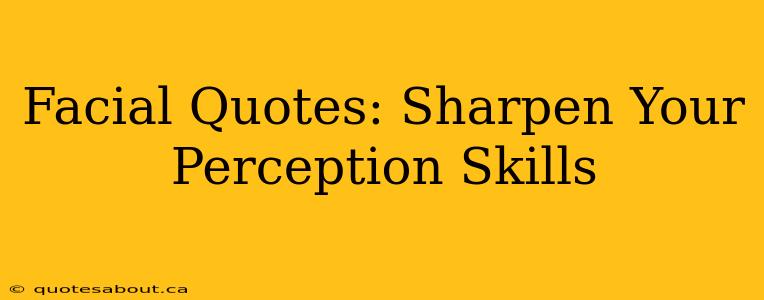Reading faces is a powerful skill. It allows you to navigate social interactions more effectively, understand unspoken emotions, and build stronger relationships. While not a perfect science, understanding facial expressions can significantly improve your perception and communication skills. This guide delves into the art of interpreting facial cues, helping you sharpen your observational abilities and become a more perceptive individual.
What are Facial Quotes?
Before we dive in, let's define "facial quotes." These aren't literal quotes spoken from the face, but rather subtle and often fleeting expressions that communicate a person's internal state. They are the micro-expressions, the subtle shifts in muscle tone, and the brief flashes of emotion that reveal what someone might be truly feeling, even if they're trying to mask it. Mastering the interpretation of these "quotes" significantly enhances your ability to understand others.
How to Improve Your Ability to Read Facial Expressions
Improving your skill in reading facial expressions takes practice and dedicated observation. Here’s a breakdown of effective strategies:
1. Focus on the Whole Face, Not Just One Feature:
Don't just look at a person's mouth or eyes in isolation. Pay attention to the entire face: eyebrows, forehead, cheeks, mouth, and even the subtle tightening or relaxing of the jaw. A complete picture emerges from the interaction of all these elements. For example, a smile might seem genuine, but furrowed eyebrows could suggest underlying tension or displeasure.
2. Observe Micro-expressions:
These are fleeting expressions that last only a fraction of a second. They often reveal a person's true feelings, even if they are trying to consciously suppress them. Practice observing these brief, almost imperceptible changes in facial muscles.
3. Pay Attention to Body Language:
Facial expressions often work in conjunction with body language. Observe posture, gestures, and overall body language to get a complete understanding of the person's emotional state. A person might smile, but if their shoulders are slumped and their arms are crossed, it suggests a different interpretation than a smile accompanied by open body language.
4. Consider Context:
The situation significantly influences the interpretation of facial expressions. A frown at a funeral has a very different meaning than a frown during a challenging game. Always consider the context to accurately interpret facial cues.
5. Practice Regularly:
Like any skill, reading faces improves with practice. Actively observe people in various situations and try to interpret their expressions. Start with people you know well and gradually expand your observations to include strangers.
What are the Key Facial Expressions to Look For?
Understanding the basics of universal facial expressions provides a solid foundation. These typically include:
- Happiness: A genuine smile involves the eyes (crow's feet) as well as the mouth.
- Sadness: Drooping mouth, furrowed eyebrows, and sometimes downcast eyes.
- Anger: Tightly clenched jaw, furrowed brows, and narrowed eyes.
- Fear: Wide eyes, raised eyebrows, and possibly a slightly open mouth.
- Surprise: Wide eyes, raised eyebrows, and an open mouth.
- Disgust: Wrinkled nose, raised upper lip, and often a furrowed brow.
Are There Cultural Differences in Facial Expressions?
Yes, while many facial expressions are universally recognized, cultural norms can significantly influence how emotions are expressed and perceived. What might be considered a polite expression in one culture could be interpreted differently in another. Awareness of cultural nuances is crucial for accurate interpretation.
How Can I Improve My Observation Skills in General?
Improving your ability to read facial expressions is intrinsically linked to improving your overall observational skills. To hone these skills further:
- Practice mindfulness: Pay close attention to your surroundings and the people around you.
- Engage all your senses: Don't rely solely on sight; incorporate sounds, smells, and other sensory inputs to build a comprehensive understanding.
- Ask questions: If you're unsure about someone's emotions, politely ask clarifying questions.
Conclusion: The Power of Perception
Mastering the art of interpreting facial quotes empowers you to connect with others on a deeper level, fostering stronger relationships and improving communication. While it requires conscious effort and dedicated practice, the rewards of sharper perception skills are significant and invaluable in all aspects of life. Remember that continuous practice and awareness are key to unlocking your potential for reading and understanding facial expressions effectively.

